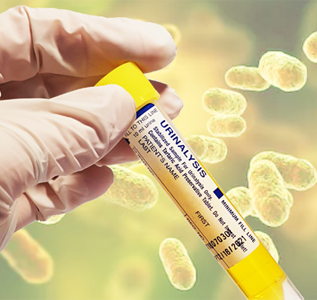Lab Test Results Interpretation Online
Complete Blood Count (CBC) Urinalysis (UA) Comprehensive Metabolic Panel (CMP) Thyroid Function Tests (TFTs) Fasting Blood Glucose TestBacteria in the Urine
Urine does not normally contain any bacteria in it. The presence of significant numbers of bacteria in urine is called "bacteriuria". Finding bacteria in the urine can mean there is an infection somewhere in the urinary tract (cystitis, urethritis, prostatitis, pyelonephritis).
Bacteria in the urine may be due to a failure to collect a urine sample properly. A clean and dry (preferably sterile) container should be used for collecting a urine sample. A midstream urine specimen is needed. Before collecting your urine, perform proper genital hygiene. For more accurate test results, several urine tests are needed.
Interpret now "Complete Blood Count (CBC)"
Interpret now "Comprehensive Metabolic Panel (CMP)"
If bacteria are found in the urine, it is necessary to identify them to choose the right treatment. A urine culture is performed. A urine sample is kept under the conditions that allow the bacteria to grow. With this test, the type of bacteria, as well as their antibiotic sensitivity, is identified.

Bacteria from the colon may contaminate the urine as well. If so, the bacteria move from the anus to the urethra, then enter the bladder and go up. This way of bacteria spreading to the urinary tract is called the ascending route of bacterial infection. This especially applies to women due to their anatomy. As for the descending route, bacteria enter the urine because of a kidney infection.
Generally, only one type of bacteria is found when a urine sample is analyzed. If several types of bacteria are found, bacterial contamination due to an improperly collected urine sample needs to be ruled out. If so, a second urinalysis is needed.
Symptoms and Signs
Generally, patients with bacteriuria exhibit other clinical signs as well. Yet, bacteria may be found in the urine of a person exhibiting no other symptoms. This condition is referred to as asymptomatic bacteriuria.
The most common symptoms of bacteria in the urine are having to urinate frequently or painful urination, lower abdominal pain, foul-smelling urine, and blood in the urine. The urine may be cloudy, have a whitish or reddish color, or contain flakes.
If the infection is located in the bladder or urethra, the body temperature normally does not rise. If the infection has spread to the kidneys, the patient’s body temperature may rise. If so, the patient may also develop dull back pain, nausea or vomiting.
Bacteria in the Urine During Pregnancy
Asymptomatic bacteriuria in pregnancy is particularly risky. A pregnant woman may fail to notice her condition that may be affecting the baby.
Bacteria are found in the urine of pregnant women 5 times as often as in the urine of non-pregnant women. A contributing factor is the growing uterus putting pressure on the kidneys preventing them from functioning normally. Pyelonephritis in pregnancy may cause preterm birth. Asymptomatic bacteriuria in pregnant women requires medical treatment as it causes pyelonephritis 20-40% of time.
Bacteria in the Urine in Children
It is usually difficult to identify the symptoms of bacteria in the urine in children. Children may experience a fever, loss of appetite or irritability, but the cause cannot be identified. Another symptom of bacteria in the urine of children is involuntary urination.
Treatment
Symptomatic urinary tract infection (UTI) usually requires antibiotic treatment. The type of antibiotics and the duration of treatment are determined individually.
Most patients with asymptomatic bacteriuria do not need antibiotic treatment. However, in some cases, an antibiotic is necessary: during pregnancy, in patients undergoing urologic procedures.
Cranberry extract does not help cure existing UTI but can help prevent its development.
+ Sources
- Mayo Clinic Staff. Urinary tract infection (UTI). (n.d.)
https://www.mayoclinic.org/diseases-conditions/urinary-tract-infection/symptoms-causes/syc-20353447 - Lindsay E Nicolle, Kalpana Gupta, Suzanne F Bradley, Richard Colgan, Gregory P DeMuri, Dimitri Drekonja, Linda O Eckert, Suzanne E Geerlings, Béla Köves, Thomas M Hooton, Manisha Juthani-Mehta, Shandra L Knight, Sanjay Saint, Anthony J Schaeffer, Barbara Trautner, Bjorn Wullt, Reed Siemieniuk, Clinical Practice Guideline for the Management of Asymptomatic Bacteriuria: 2019 Update by the Infectious Diseases Society of America, Clinical Infectious Diseases, Volume 68, Issue 10, 15 May 2019, Pages e83–e110,
https://doi.org/10.1093/cid/ciy1121 - Bladder Infection (Urinary Tract Infection—UTI) in Adults. (n.d.)
https://www.niddk.nih.gov/health-information/urologic-diseases/bladder-infection-uti-in-adults - Wang CH, Fang CC, Chen NC, et al. Cranberry-containing products for prevention of urinary tract infections in susceptible populations: a systematic review and meta-analysis of randomized controlled trials. Arch Intern Med. 2012;172(13):988–996.
https://doi.org/10.1001/archinternmed.2012.3004